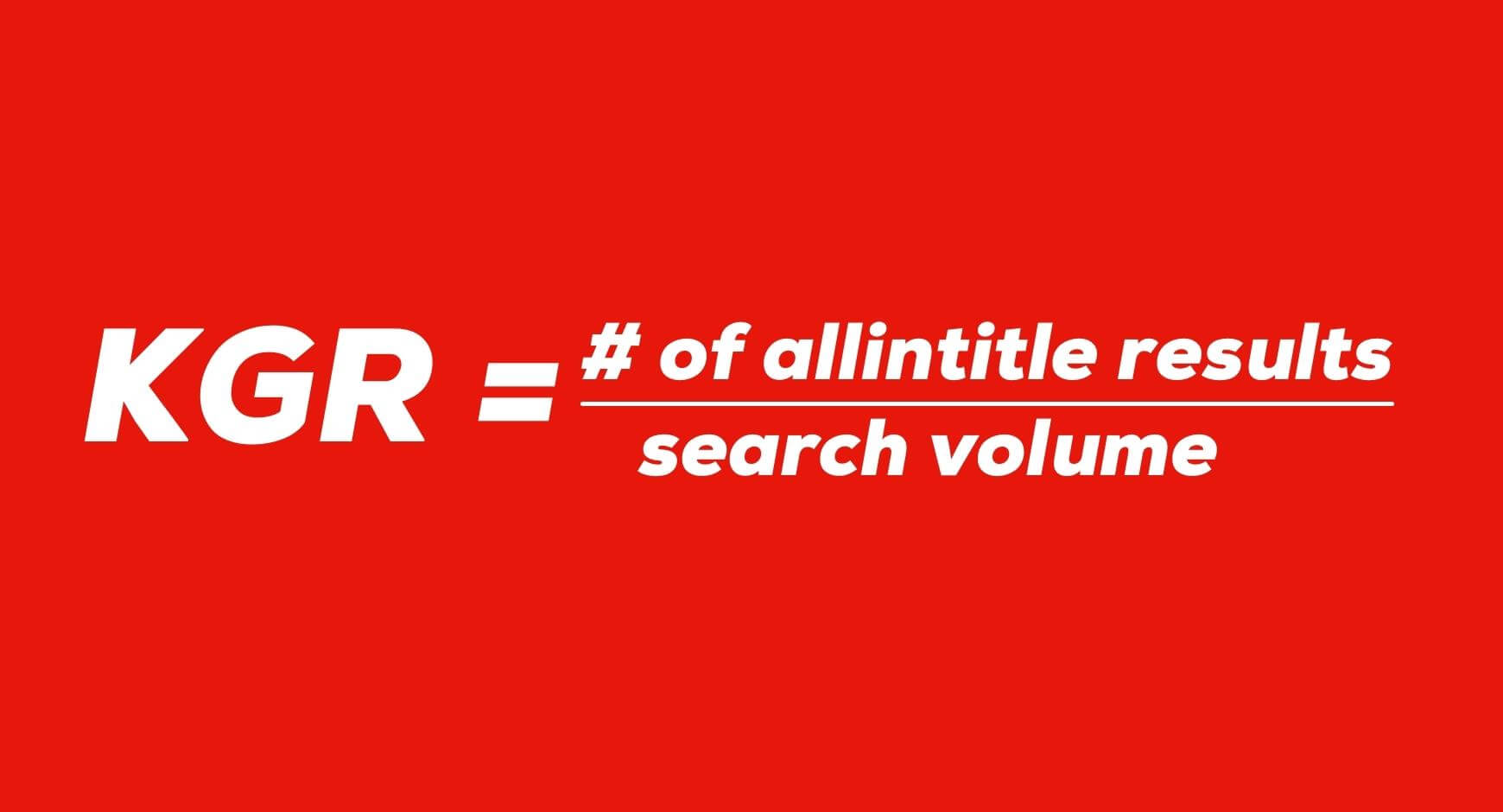If you are looking for a way to improve your ranking in Google searches, the Keyword Golden Ratio is the solution you need! Building organic traffic to your website or blog can take months, but using the Keyword Golden Ratio effectively can help you rank higher, faster.
At its core, the Keyword Golden Ratio is about supply and demand. If a keyword has more content ranking in Search Engine Results Pages (SERPs) than there are people who are searching for that keyword, then there is more supply than demand. This is often the case with popular keywords.
On the other hand, a keyword with less content ranking in the SERPs may have more demand than supply. Therefore, you have a better chance of ranking higher in a shorter amount of time.
This article will teach you how to rank keywords fast using the Keyword Golden Ratio to increase traffic to your site and subsequently increase your revenue.
Explore Augurian’s blog for more great content marketing tactics from the experts.
Table of contents:
- What is the Keyword Golden Ratio?
- How Does the Ratio Actually Work?
- How to Calculate KGR
- Reasons to Use the KGR Method
- Risks of KGR for SEO
- How to Find Golden Keywords
What is the Keyword Golden Ratio?
The Keyword Golden Ratio strategy is a cornerstone of SEO. It entails identifying low-volume keywords to focus on for online content in order to rank higher in SERPs. It’s a great technique for new businesses and businesses that are trying to increase their online sales because it directs more organic traffic to those websites.
Using popular keywords may mean you don’t rank in the top ten SERPs for months. The Keyword Golden Ratio increases your chances of ranking higher much more quickly by using less popular keywords. If you want to grow your organic traffic quickly, then you will likely benefit from the Keyword Golden Ratio, also called the KGR ratio. Pretty much anyone who writes online content can use the KGR to their advantage.
How Does the Ratio Actually Work?
The Keyword Golden Ratio works by targeting less popular keywords in content in order to boost your ranking in SERPs. The sweet spot for quick ranking is a monthly search volume of 250 or less. Any more than that and there is too much competition for new websites and pages to rank high in the search results.
Search volume is the number of times a certain keyword is searched for in a specified amount of time — usually one month. The KGR ratio compares the search volume to the number of results for that specific keyword to identify keywords without much competition. For a site to rank on the SERPs for that keyword, the keyword must be in the title.
“[Keyword Golden Ratio] measures the number of people trying to rank for a term. If the monthly search volume is higher than the number of people ranking for this, that’s an indicator [that tells you]… Okay, we can probably rank pretty highly for this.” – Sean Higgins, Founder of BetterYou
In a nutshell, the Keyword Golden Ratio method works like this:
- You identify a relevant keyword that has a monthly search volume of 250 or less
- You search the keyword term to ensure it has less than 63 title results
- Your team writes quality content using the keyword in the title
- The content ranks high on the SERPs because it has minimal competition
How to Calculate KGR
The Keyword Golden Ratio is a metric, which means some math is involved to calculate the ratio. The good news is it’s a very simple calculation. Divide the number of title results for a specific keyword by the monthly local search volume for that keyword. The answer represents the Golden Keyword Ratio or KGR. If you followed the directions in the previous section when choosing your keyword, the ratio will always be .25 or less. A lower ratio means less competition for your content.
What is Allintitle?
The allintitle feature allows you to use Google to search how many results rank for a specific keyword. Anyone can use allintitle to determine the amount of content that already ranks for a keyword. To utilize the feature, type allintitle:(the keyword) in the Google search bar with no space between the colon and the keyword.
Keyword Competition Formula
KGR = (number of title results) / (local monthly search volume)
Let’s explore an example of how this keyword competition formula works in practice. Say your company sells various smart home products, and you are writing a blog post about smart garage door openers to funnel traffic to your website. If the keyword “DIY smart garage door opener installation” has 30 title results in an allintitle Google search and a search volume of 150, then the keyword ratio is .20. This means a quality SEO article has a very high chance of ranking on the first page of the SERPs with this golden keyword.
Reasons to Use the KGR Method
The number one reason to utilize the KGR method when writing content is to increase traffic to your site. However, there are several other less obvious benefits. No business or webpage is exactly like another, and the KGR method can have many advantages.
Motivation
Growing organic traffic can be a long process that requires a lot of waiting before you start ranking high in search engines. Using the Keyword Golden Ratio for some (but not all) of your content can provide the little wins that your team needs to stay motivated as your business grows.
Develop Clear Priorities
There are seemingly endless options for keywords. The KGR SEO strategy gives you guidance on how to rank keywords faster by choosing under-utilized phrases in your content.
“KGR gives us an idea of which topics we should actually be writing about, creating white papers about, etc. and it’s helped us rank.” – Sean Higgins, Founder of BetterYou
Objectivity
With the Keyword Golden Ratio, choosing target keywords for your content doesn’t have to be a subjective process. You can objectively determine the keywords for which you will rank the highest in SERPs by using the KGR formula. A lower ratio means a higher chance of ranking in the top 25 results.
Set Yourself Apart
Under-utilized long-tail keywords often represent the niche needs of a specific customer segment that has more demand than supply. Creating content specifically for these niche markets can help increase your conversions by bringing new, relevant traffic to your site. You will be offering content that other sites simply don’t have.
Beat Competitors
Using Google’s search engine is a daily occurrence for most Americans, and let’s face it, we often click on the first result from the first page without looking through the other results. That’s why learning how to rank keywords fast can help you outgrow your competitors.
Another way to beat competitors is to research the keywords that your competitors are using to try and outrank them in the SERPs. Once you have compiled a list of competitors’ keywords, you can use the KGR to objectively determine which ones you should go after as well.
Risks of KGR for SEO
Using the KGR method with efficacy requires a balance of writing quality content and tailoring that content for SEO. If you are new to SEO content writing or just looking to increase your skills, check out our tips for writing killer SEO content.
Now let’s explore some of the pitfalls associated with using the Keyword Golden Ratio and how to avoid them.
Keyword Stuffing
Just because a keyword has a high chance of ranking you in the SERPs does not mean you should automatically put it in your content. Keyword stuffing means overusing one or more keywords in the same content with the goal of ranking higher, faster. Truthfully, more is not always better. Keyword stuffing is frowned upon by search engines. In fact, Google may remove your page from the SERPs completely if they suspect you are keyword stuffing, so it’s important to avoid it!
Avoid the following characteristics of keyword stuffing:
- A high keyword density
- Keywords used unnaturally or out of context
- Blocks of text with the same keyword repeated
At Augurian, we never sacrifice quality for search rankings. Our content marketing team is made up of experts in SEO and content creation, melding the two to build online presence and authority for our clients.
Dead End Topics
The goal of great content is to increase traffic to your site in order to move potential customers down the customer journey funnel. Therefore, good keywords should provide lots of opportunities to link to other content and pages. If you have a keyword with a great KGR, but it doesn’t allow for natural progression to related topics, then it’s not beneficial to use.
You want topics that allow for a lot of content without too much repetition of ideas because duplicate content may negatively affect your site’s search engine rankings.
Limited Number of Terms
Remember that the KGR terms you use should:
- Have a ratio of .25 or less
- Have a search volume of 250 or less
- Be relevant to your business
- Provide links to other relevant content and pages
Depending on the topic of your content, there may be a very limited number of terms that qualify as golden keywords. This increases risk when using KGR because the method works best in bulk. You likely won’t see a significant amount of increased traffic with just a couple of golden keywords.
Compiling a list of golden keywords that are relevant to your website before creating any content with the keywords can help you avoid wasting your time on a strategy that’s not going to get you the results you want.
How to Find Golden Keywords
Once you understand the KGR method, finding golden keywords that are relevant for your business or website and calculating the ratio becomes a fairly simple process. It can be time-consuming to compile your initial list of keywords, but this front-end work will pay off in the long run as you build the online credibility and authority needed to rank high in SERPs.
Find Relevant and Low Search Terms
The first step of KGR is keyword research. There are numerous content marketing tools that aid in keyword research such as SEMRush and Google Trends.
When conducting keyword research:
- Brainstorm a list of relevant topics about which you could create content
- Research the search volumes of keywords for those topics
- Establish a system for KGR tracking such as a spreadsheet
Eliminate Search Volumes Above 250
Remove all potential keywords from your list that have search volumes above 250. If you are using an online tool to research and track keywords, there is likely a feature to set a maximum search volume. This allows you to quickly filter potential keywords and speed up the researching process because you will only see keywords that qualify for the KGR method.
Organize Results Based on Difficulty and Length
An important metric that we haven’t touched on yet is keyword difficulty. Keyword difficulty is approximately how hard it is to rank in the top ten search results. You can use your preferred content marketing tool to find keyword difficulties. You should prioritize using keywords that have a difficulty of less than five.
Next, you should filter your keyword list based on the length of the keywords. Generally, long-tail keywords (those with five or more words) have a lower search volume and therefore are a better fit for the KGR method.
Here’s an overview of these important steps:
- Add keyword difficulties to your spreadsheet of golden keywords
- Add the length (number of words) of each keyword phrase to the spreadsheet
- Sort the spreadsheet based on keyword difficulty and length
- Prioritize long-tail keywords with the lowest keyword difficulties
Determine Allintitle Results
Complete an allintitle Google search for your keyword. For example, “allintitle:keto meal kit delivery” shows 128 title results. Record this information on your KGR tracking spreadsheet. You will need this number to calculate the Golden Keyword Ratio.
Calculate KGR
Once you have the monthly search volume and allintitle results, you will plug these numbers into the keyword competition formula.
To calculate KGR:
- Divide the number of allintitle results by the monthly search volume
- Confirm that the answer is a number that is .25 or less — this is the KGR
- Record the number on your keyword spreadsheet
What About Non-KGR-Compliant Keywords?
Keep in mind that a keyword can have a ratio of less than .25 but still not be KGR compliant. For example, a keyword with only ten title results but a search volume of 400 doesn’t fit the requirements of the Keyboard Golden Ratio. However, that doesn’t mean you should automatically throw that keyword out.
When considering whether or not to use non-KGR compliant keywords, take the following factors into account:
- The number of allintitle search results
- The relevance of the keyword to your business
- The stage of customer discovery that the keyword targets
Explore Augurian’s Blog for More Tips to Boost Your SEO Performance
The Keyword Golden Ratio helps you rank higher and faster in search engine results using the keyword competition formula. It’s an ideal SEO strategy for newer websites that are looking to grow their organic traffic.
For more content marketing and SEO tips, check out Augurian’s blog. It’s chock-full of articles and interviews with industry experts to help you learn everything from the essential metrics you should be calculating to how to write content for different stages of the customer journey.
Still not sure which keywords you should and shouldn’t be using? Let our SEO experts help demystify the process for you to maximize relevant traffic and conversions.










